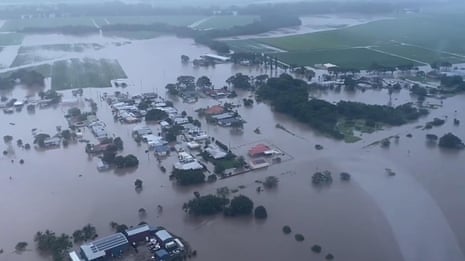South-eastern states sweltering in a heatwave may be waiting until late Tuesday or Wednesday for a cool change to bring some relief.
Melbourne and Adelaide were in for another very hot day on Monday, after highs of 38C and 39C on Sunday. The Bureau of Meteorology was forecasting Adelaide to reach 41C and Melbourne 39C on Monday, followed by another hot day on Tuesday for both cities.
The senior BoM meteorologist Miriam Bradbury said the three-day run of “intensely hot” weather was remarkable, particularly given the last time Melbourne had three days in a row over 37C was in 2014.
“[In] all of these areas we’re pretty used to seeing one hot day, maybe two hot days, but getting a stretch of three or more in a row is fairly unusual,” she said.
Three or more days of unusually hot weather triggered heatwave conditions, and also meant very warm nights in between very hot days, Bradbury said.
“That does have an impact on the body, where we can’t recuperate from the heat of the day.”
Large parts of South Australia and Victoria were forecast to reach temperatures in the high 30s and even 40s.
Bendigo, Mildura and the Latrobe Valley were expected to reach 39C and Shepparton 40C. Warrnambool, on the south-west coast of Victoria, had recorded 37.2C by 11.30am.
The Victorian premier, Jacinta Allan, said several days of extreme temperatures had a cumulative effect, particularly on vulnerable people.
“So if you can, please check in on your loved ones, please check in on your neighbour and also look after yourself as we go through this period of extreme heat.”
Heatwaves are Australia’s deadliest natural phenomenon, killing more people than bushfires, floods and storms.
The Victorian government’s Better Health Channel outlined the symptoms of heat-related illness including cramps, exhaustion and heatstroke, and offered advice on staying cool, including drinking plenty of water, spending time in air-conditioned spaces, wearing light and loose clothing, and taking cool showers or keeping skin wet.
Temperatures in Ceduna, an eight-hour drive north-west of Adelaide, had already hit 39.9C by 11am. Maximums in the 40s were expected in Murray Bridge, Port Augusta, Renmark and Whyalla.
Hobart was expected to hit 33C on Monday, which was “really hot compared to how it usually should be in summer”, Bradbury said. She said the average for Hobart in February was 21.8C.
Temperatures at least 10C above average was a “common story across much of the south-eastern part of the country today”, she said.
after newsletter promotion
Widespread thunderstorm activity in Melbourne, “which seemed to rage for hours” on Sunday night, had not brought cooler weather, Bradbury said.
Melburnians would have to wait until Tuesday evening or Wednesday morning for a cold front to bring temperatures back down and “hopefully a much better sleep”, she said.
High fire danger was forecast for fire districts across much of the south-east.
Allan said two fires continued to burn in the Grampians national park, and blazes had developed in the Colac Otway region, around the north and west of Apollo Bay.
“There are huge resources, ground resources, being deployed right now to get on top of this fire,” she said.
Fires in the Little Desert national park and Hattah were under control, she said.
In Western Australia, another surge of heat was building, pushing temperatures well above average across much of the state’s south by Thursday and Friday. That would extend across the rest of southern Australia by next weekend, Bradbury said.
Perth had already seen a number of prolonged periods of heat during the 2024-25 summer, a pattern that was likely to continue, she said.
“It’s this cycle that we’ve seen quite a bit, where, as soon as one burst of heat clears the east coast, we get another burst of heat building in the west coming across.”
The forecast for Sydney was “much more bearable than for Melbourne”, Bradbury said, with temperatures “topping out” at about 30C.
Australia’s land surface has warmed by 1.5C since 1910, according to BoM, with the climate crisis making heatwaves longer and more intense, and increasing the number of extremely hot days.






